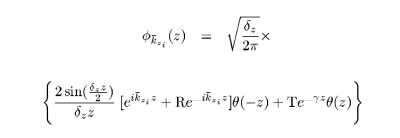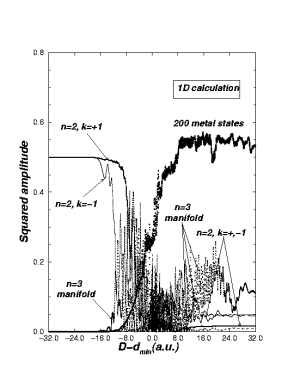
ELECTRON TRANSFER IN SLOW ATOM-SURFACE COLLISIONS: A CLOSE-COUPLING APPROACH WITH CONTINUUM DISCRETIZATION
Bogdana Bahrim and Uwe Thumm
JRM Laboratory, Department of Physics, Kansas State University
Manhattan, Kansas, USA
Charge transfer during atom-metal surface collisions has received much interest in the last decade. In contrast to other close-coupling approaches1, we discretize the active electron's motion inside the metal using Weyl wave packets2. These stationary wave packets have the advantage of being localized at the surface, where the electronic interactions occur. The use of discretized states to represent the conduction-band continuum allows for the convenient inclusion of (one electron) inelastic processes inside the substrate.
We solve the time-dependent Schrödinger equation
as a system of coupled differential equations for the
atomic and metallic population amplitudes, using a
two-center expansion for the total wavefunction of the
active electron3. The "metallic part" of the total
wavefunction is discretized in momentum space in a finite
triple sum (corresponding to the Ox, Oy and Oz directions)
of Weyl wave packets. For the electron motion
along the normal to the surface, wave packets are obtained
by superimposing jellium wave functions within
a small interval δz about the centroid
momentum kzi,

The system of close-coupled equations is integrated numerically. We have studied the evolution of the atomic and metallic population amplitudes for a Hydrogen atom at perpendicular incidence on an Aluminum surface with speed vz=0.02 a.u. Hybridization effects have been investigated, indicating that a significant part of the hybridization near a metal surface corresponds to the "Stark-like" mixing of spherical hydrogenic states in the non-uniform field of the surface.
Figure 1 shows the squared amplitudes in parabolic representation of the n = 2, k = -1,+1 states, of all n = 3 states, and of all 200 Weyl packets used to discretize the conduction band continuum, as a function of D-dmin. D is the atom-surface distance and dmin=0.5 a.u. the distance of closest approach.
We have also found that the atomic and metallic populations at the end of the collision are very sensitive to the screening of the interaction potential which couples the metal states.
Figures:

References:
1) P. Kiirpick, U. Thumm, and U. Wille, Phys. Rev. A 57, 1920 (1998)
2) G. Schiwietz, Phys. Rev. A 42, 296 (1990)
3) B. Bahrim. and U. Thumm, Surf. Sci. 451, 1 (2000)
This work was supported by the
Chemical Sciences, Geosciences and Biosciences Division,
Office of Basic Energy Sciences,
Office of Science,
U.S. Department of Energy.
Submitted to ICPEAC 2001, July 2001 in Santa Fe, NM.
This abstract is also available in Postscript or Adobe Acrobat formats.
|
|